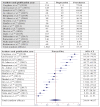The Frequency of Neuropsychiatric Sequelae After Traumatic Brain Injury in the Global South: A systematic review and meta-analysis
- PMID: 38828247
- PMCID: PMC11139369
- DOI: 10.18295/squmj.12.2023.088
The Frequency of Neuropsychiatric Sequelae After Traumatic Brain Injury in the Global South: A systematic review and meta-analysis
Abstract
This study aimed to assess the prevalence of neuropsychiatric sequelae following traumatic brain injury (TBI) among the Western Asian, South Asian and African regions of the global south. All studies on psychiatric disturbances or cognitive impairment following TBI conducted (until August 2021) in the 83 countries that constitute the aforementioned regions were reviewed; 6 databases were selected for the literature search. After evaluating the articles using the Joanna Briggs Institute guidelines, the random effects model was used to estimate the prevalence of depression, anxiety, post-traumatic stress disorder (PTSD), TBI-related sleep disturbance (TBI-SD), obsessive-compulsive disorder (OCD) and cognitive impairment. Of 56 non-duplicated studies identified in the initial search, 27 were eligible for systematic review and 23 for meta-analysis. The pooled prevalence of depression in 1,882 samples was 35.35%, that of anxiety in 1,211 samples was 28.64%, that of PTSD in 426 samples was 19.94%, that of OCD in 313 samples was 19.48%, that of TBI-SD in 562 samples was 26.67% and that of cognitive impairment in 941 samples was 49.10%. To date, this is the first critical review to examine the spectrum of post-TBI neuropsychiatric sequelae in the specified regions. Although existing studies lack homogeneous data due to variability in the diagnostic tools and outcome measures utilised, the reported prevalence rates are significant and comparable to statistics from the global north.
Keywords: Anxiety; Cognitive Impairment; Depression; Meta-analysis; Neuropsychiatry; Systematic Review; Traumatic Brain Injury.
© Copyright 2024, Sultan Qaboos University Medical Journal, All Rights Reserved.
Figures






Similar articles
-
The prevalence of anxiety, depression, and post-traumatic stress disorder among African migrants: A systematic review and meta-analysis.Psychiatry Res. 2022 Nov;317:114899. doi: 10.1016/j.psychres.2022.114899. Epub 2022 Oct 10. Psychiatry Res. 2022. PMID: 36252417
-
Pharmacotherapy for anxiety and comorbid alcohol use disorders.Cochrane Database Syst Rev. 2015 Jan 20;1(1):CD007505. doi: 10.1002/14651858.CD007505.pub2. Cochrane Database Syst Rev. 2015. PMID: 25601826 Free PMC article.
-
Cognitive behavioural therapy and third-wave approaches for anxiety and related disorders in older people.Cochrane Database Syst Rev. 2024 Jul 8;7(7):CD007674. doi: 10.1002/14651858.CD007674.pub3. Cochrane Database Syst Rev. 2024. PMID: 38973756 Free PMC article.
-
Psychological and pharmacological interventions for posttraumatic stress disorder and comorbid mental health problems following complex traumatic events: Systematic review and component network meta-analysis.PLoS Med. 2020 Aug 19;17(8):e1003262. doi: 10.1371/journal.pmed.1003262. eCollection 2020 Aug. PLoS Med. 2020. PMID: 32813696 Free PMC article.
-
Pharmacotherapy for chronic cognitive impairment in traumatic brain injury.Cochrane Database Syst Rev. 2015 Dec 1;2015(12):CD009221. doi: 10.1002/14651858.CD009221.pub2. Cochrane Database Syst Rev. 2015. PMID: 26624881 Free PMC article.
Cited by
-
Bridging the Global Divide: Advancing Traumatic Brain Injury Research Through Globally Representative Data.Neurocrit Care. 2025 Aug;43(1):3-7. doi: 10.1007/s12028-025-02271-8. Epub 2025 Apr 14. Neurocrit Care. 2025. PMID: 40229632
References
Publication types
MeSH terms
LinkOut - more resources
Full Text Sources
Medical
